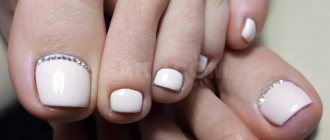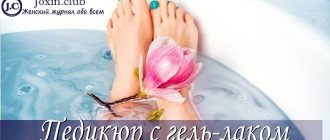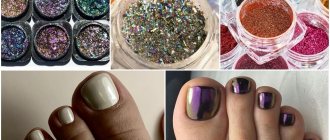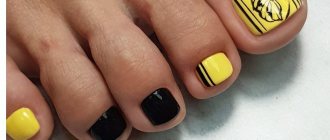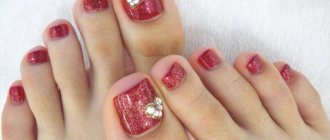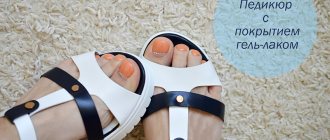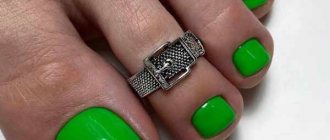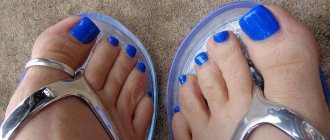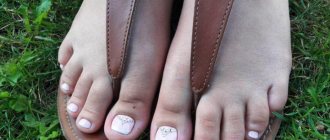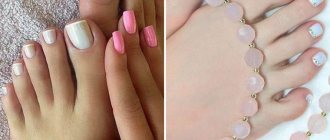Rating: No rating
Delicate heels, which you just want to show off while showing off in open shoes, become especially relevant in the summer.
And ladies, who just yesterday forgot to sign up for a pedicure, are frantically rushing around in search of a miracle remedy that can literally transform their feet in one session, restoring their smoothness, like a baby’s.
An acid pedicure can help in this case. Don't let the name scare you - the compounds used do not pose any danger. Moreover, this procedure can be carried out while expecting a baby, and even during adolescence.
What is the essence of this pedicure, what drugs are used and can it be done at home? We'll talk about this further.
Concept and indications for the procedure
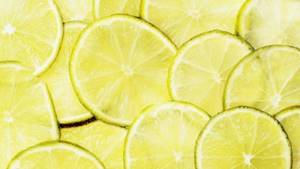
Acid pedicure is the treatment of feet and getting rid of dead cells using special products made from fruit acids.
This treatment option is a type of unedged pedicure, but involves the use of exclusively acid-based products. Indications for acid pedicure :
- increased formation of growths. The more aggressive the method of treating growths, the faster they grow. If, after a trim or hardware pedicure, new keratinization quickly forms, pay attention to treatment with acids;
- long healing. Fruit acids start the regeneration process. As a result, the skin heals faster, becomes more elastic and softer;
- core calluses;
- mycoses;
- yellowish tint of the skin of the feet;
- ingrown nails;
- wet foot, hyperhidrosis.
It is important that acid pedicure has a narrow list of contraindications. It can be done during pregnancy, as well as for children and adolescents.
Foot skin problems and what a pedicurist should do if they exist
Cracks in the skin of the heels - treatment and prevention
Advantages and disadvantages
Before you perform an acid foot treatment in a salon or at home, pay attention to the advantages and disadvantages of using the composition.
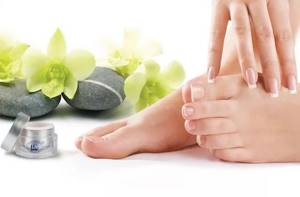
Since the method is aimed at improving the condition of the legs, it has many positive aspects:
- Safe removal of keratinized epithelial cells. This is due to the fact that instead of mechanical methods, the method of applying the drug is used.
- Corns and calluses are completely removed from the surface of the feet, the epidermis becomes tender and soft.
- There are no contraindications and possible consequences after performing the technique.
- Long-term preservation of the effect. It is recommended to perform the procedure once a month.
- You can do it yourself at home.
When carrying out the technique at home, the girl saves time on visiting a pedicure salon and money on the services of a specialist.
But there are also disadvantages to the procedure:
- It is not recommended to carry out the technology if you have thin, sensitive skin.
- If your feet have dry skin, there is a risk of peeling after work.
To prevent side effects after a cosmetic procedure, rinse off the remover thoroughly to prevent the epidermis from drying out.
Advantages and disadvantages

Let's start with the positives:
- a quick, simple and inexpensive procedure allows the master to take on more clients, but without compromising quality;
- comfort and safety. The client no longer worries about whether you have sterilized the instrument or whether you will cut his heel. And also, as clients say, an acid pedicure is not as ticklish as other types of manicure;
- long-term result. After a non-aggressive effect on the skin, new growths form more slowly, which allows you to reduce the number of trips to the specialist for foot treatment. Some women who have tried acid pedicure claim that the results last up to 3 months.
Flaws:
- acids may not cope with severe roughness. Most likely, with advanced hyperkeratosis, it will not be possible to achieve results immediately - the procedures will have to be repeated often at first, once every 1.5-2 weeks;
- Although relatively safe, acid pedicures can be harmful to the skin if left on for too long. The technician must determine the required exposure time individually based on the condition of the skin and nails.
Selection of means for the procedure
Before choosing a suitable acid peeling product, it is worth studying the composition. The main active ingredient is fruit acid. In addition to acid, the cream may contain flavors, herbs, and other excipients. They are designed to soothe the skin, have a pleasant scent, etc.
To carry out acid peeling at home, you should not take the cream in jars with a large volume; a volume of 50-60 milliliters will be enough.
Another important component that may be included in the cream is glycolic acid . It copes with the tasks no less effectively than fruit acid and provides a long-lasting effect.
Professional manicurists and pedicurists use the American product My Nail in particularly difficult cases to remove calluses and old corns. It is not recommended for use at home, as it can cause chemical burns if the instructions for use are not followed. This company also produces other products with a more delicate and mild effect on the skin.
Professionals also often use and respond positively to acid peeling products such as Naomi from the Japanese manufacturer and Kart from the famous Israeli brand. In addition to the fact that these products gently and effectively soften the skin of the feet, remove dead skin cells, they have antimicrobial and anti-inflammatory effects.
Farmeffect cream is considered to be quite famous and in demand . It is used by professionals as a means for acid peeling, and also as a basis for preparing for classic unedged and hardware pedicures.
Among the well-known Russian products one can note SAGITTA Cosmetics . This is an acid cream, which contains both fruit and lactic acids. It has a mild effect, does not dry out the skin, does not cause burning or discomfort when used.
We can highlight another fairly well-known cream from a British manufacturer - Derma Pharms . This is a universal product that is successfully used to care for hands and feet not only for women, but also for men of any age category.
Differences from other types of pedicure
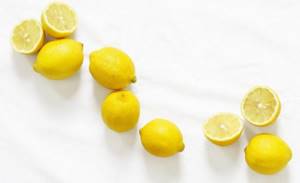
- low chance of infection. Acids dissolve only the stratum corneum and do not violate the integrity of healthy skin, so the risk of infection is minimal compared to the cutting or even hardware method;
- comfort. During the procedure, the client does not experience any unpleasant sensations, while the edged one can cause acute pain from cuts, and the hardware one can cause a burning sensation;
- simplicity. The technician does not need to rub, cut or saw anything - simply apply the acidic agent to the keratinized areas and wait the time prescribed in the instructions. Softened skin can be easily removed with gentle movements with a pedicure grater;
- low level of allergenicity . Keratolytics with urea, for example, cannot be used by people with hypersensitivity, while acid preparations practically do not cause allergies;
- absence of dust, as with a hardware pedicure . This fact is especially important for craftsmen who have to breathe small particles of skin throughout the working day;
- One of the common questions is how the acid method differs from, say, a pedicure using alkaline keratolytics . The main difference is safety - alkaline products are quite aggressive, can leave a burn, and also cause increased dryness of the skin. Acidic ones are more gentle in this regard;
- Another common comparison is acid pedicure and peeling socks. The main difference here is the action - after using the socks, the result is not immediate and often causes discomfort. The skin peels off for a few days, peels off and does not look very attractive in appearance. After an acid pedicure, there are no peelings or skin coming off in layers. In addition, the composition of the socks is distributed over the entire foot, and therefore over keratinized and healthy skin, while acidic products are applied only to problem areas.
Types of keratolytics used in pedicure: a complete guide for masters
Pedicure socks - what types are there, how to use them
Enzymes
Golden Trace, Elixir for feet - 2,000 rub.
Enzyme preparations are the newest trend in preparative pedicure. Pedicures with them are significantly more expensive, and there are still few drugs on the market. At the moment, they are the softest and safest: their mechanism of operation does not involve gross destruction of dead skin, but is focused on stimulating the natural exfoliation of dead cells. Simply put, these drugs break down the bonds between living and dead cells. The drug is applied to the entire foot and starts the keratolysis process within 10–12 minutes. The use of a neutralizer is not required.
You shouldn't expect a wow effect on neglected legs from enzyme preparations. To achieve the “baby heels” effect, a course of 10–12 procedures is required with an interval of a month and a half. But their effect is amazing: over time, the interval between procedures increases, feet become healthier, cracks disappear, and corns decrease. The ideal skin pattern can be viewed even under a microscope!
But before starting the procedure, we recommend that you read: 4 taboos of a home pedicure. The master tells.
How to do an acid pedicure

The steps of an acid pedicure may vary slightly depending on the manufacturer of the cosmetics used for this procedure. Let's look at the general steps first, and then two popular brands and their unique procedures.
Instructions for performing an acid pedicure:
- Cleansing. The skin of the feet is thoroughly cleansed with a special product or cloth to remove external impurities;
- Disinfection. An antiseptic must be used, which is applied to the skin after the feet have completely dried after the previous stage;
- Application of products with acids . Apply a product containing acids to problem areas of the foot - the heels, the pad under the big toe and the sides and leave for the time specified in the instructions. At this stage, it is important to take into account that different degrees of keratinization require different exposure times. In neglected areas, you need to withstand the entire time specified by the manufacturer, and where the roughness is insignificant, half is enough;
- If the exposure time is long - more than 5-7 minutes, you can do your fingers at this time. The fingers and side rollers can be processed with a milling cutter, grater or laser file. Some people combine an acid pedicure with a trim pedicure, but this way all its safety and painlessness are lost;
- Next, remove the remaining composition with a napkin, and remove the softened layer with a grater;
- At the final stage, the skin of the feet is moisturized. If desired, gel polish, clear or colored varnish can be applied.
Photos before and after
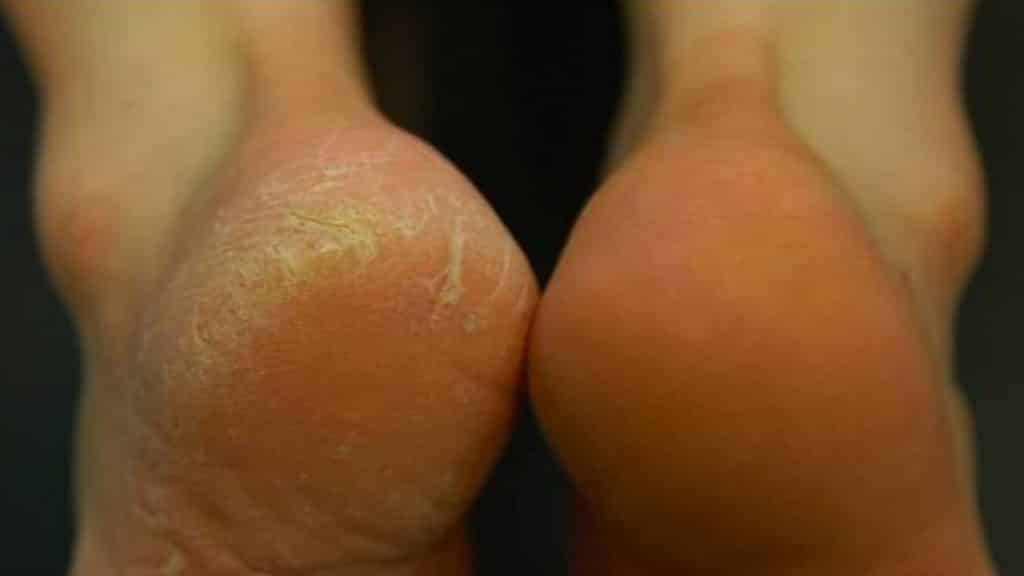
Conclusion:
Acid pedicure is an excellent remedy for combating excessive sweating, unpleasant odor, corns, calluses, etc. With the help of special creams and gels, you can take care of the skin of your feet without any harm to your health, without resorting to the help of professionals. To do this, it is enough to study the features of the procedure and follow all precautions.
KART technology
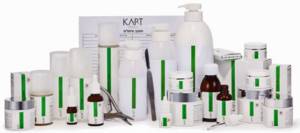
Kart is an Israeli company producing cosmetics for manicure and pedicure. KART cosmetics cannot be called budget. However, this is compensated by the economical expenditure of funds and long-term results.
Some products are suitable for independent and professional use, while others are suitable exclusively for beauty salons and experienced professionals.
Kart’s assortment includes products for ingrown toenails, calluses, and problem feet, but we won’t discuss them all in this article and will focus on acid pedicure technology.
To perform a classic Kart pedicure you will need:
- liquid foot soap Kart
- Enzyme peeling for feet with acids
- cuticle remover gel
- cream for dry and cracked feet.
If the problems are serious - there are core calluses, keratinization, ingrown nails, hyperkeratosis, other products from the line are additionally used - peeling gel, Mokopil callus softening gel.
Performing an acid pedicure using KART technology:
- Wash your feet using liquid soap with fruit acids. This will cleanse the feet of external contaminants, as well as prepare the skin for further manipulation. Do not soak your feet in the bath - the pedicure must be dry and all actions with water are for hygienic purposes only;
- Apply foot peeling to problem areas, but do not rub in - just distribute evenly. You can use the product, including between your fingers and on cracks. Wrap your feet in cling film for 10-15 minutes;
- While the acids are working on the keratinized areas, take care of your nails - apply Cuticle Remover softener to the cuticles and leave for 3-5 minutes. Push back the softened skin with an orange stick;
- Remove the film from your feet, remove the remaining peeling with a damp cloth;
- Using a grater or scalpel, remove the destroyed stratum corneum . Treat your fingers and nails using convenient equipment - hardware, European, classical;
- Rinse your feet in warm water to remove any remaining skin and product . Wipe dry with a towel;
- Apply cream.
If you plan to apply gel polish after the procedure, do not forget to degrease the nail plate.
How does the procedure work?
As at the beginning of a standard pedicure, you first need to clean the legs, prepare them for work, and remove the previous decorative coating from the nails (if there was any).
Acid technology usually takes less time than using graters or blades to remove corns and calluses - up to forty minutes. This is due to the speed of breakdown of keratinized epithelial cells.
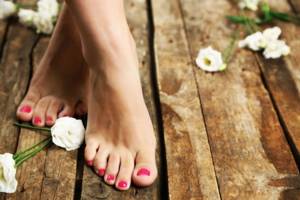
To get a positive result, follow the step-by-step pedicure instructions:
- Take a warming foot bath. You can add caring ingredients to it - sea salt or cosmetic oil. The water should not be hot. It is recommended to make it warm (up to forty degrees Celsius).
- Wear gloves to prevent aggressive effects on the skin of your hands and apply the product to the epidermal areas of your legs. You can take two removers (gentle and aggressive) to treat different areas of the feet. If the solution has a liquid consistency, you can first apply them to napkins, and then attach the napkins to your feet. This will prevent the solution from dripping.
- Wrap your feet in two or three layers of cling film and put on warm socks. At this time, it is recommended to lie down without getting up.
- After 10 minutes, remove the compress, remove the wipes with most of the remover and remove the remaining residue with a damp cloth or towel.
- Review the processing quality. If there are rough areas (calluses/corns), use additional pumice stones of varying hardness. You need to finish the manipulations with a low-abrasive grater to polish the surface of the skin.
- Treat your nails. To do this, use a metal pusher or an orange stick to push the cuticle to the base after applying the remover and cut it off with forceps. You can use a device with several cutters to remove pterygium from the surface of the nail plate. After that, use a buff to polish your nails. Remove excess sawdust with a brush.
- Use a file to remove the overgrown length of the free edge and give it a neat shape.
- If desired, you can decorate the nails. To do this, after rough manipulations, degrease it and begin applying the base, colored gel polish, top coat, periodically drying the layers in an ultraviolet lamp.
If the manipulations are carried out correctly, the girl does not feel discomfort during work, since the hypoallergenic acid composition does not cause skin irritation. Due to the safety of pedicure, it can be done at home, with periodic correction of the work.
ADN technology

For a pedicure with ADN acids you will need:
- “Free Feet” foot soap;
- Foot Piling Mask;
- cuticle gel Cuticle Remover ADN;
- Cracked Skin Cream.
There are other products in the line aimed at solving the problem of thick nails, calluses and corns, but we will look at a classic pedicure to understand the scheme.
Step-by-step instructions for acid pedicure using ADN technology:
- Apply a small amount of soap to your feet and massage into a lather. Massage your feet for 2-3 minutes to wash away impurities and prepare the skin;
- Rinse off the soap with warm water and dry your feet with a towel;
- Apply the Foot Piling Mask to the entire surface of the foot - do not rub;
- If hyperkeratosis is present, use Liquid Peeling Strong peeling water locally. Water is applied to a cotton pad or napkin and applied to the problem area directly on top of the mask;
- Wrap your feet in cling film and leave for 10 minutes;
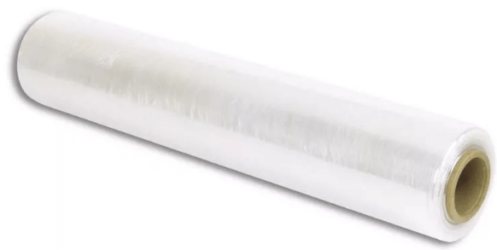
- While the skin is softening, lubricate the cuticle with Cuticle Remover gel and leave for 30 seconds. After this time, move the softened skin with an orange stick;
- Pedicure on the fingers is done using a convenient technique, most often in a European one - without a device or cuts. The side rollers are polished with a soft grater, the cuticle is moved to the base and is not trimmed.
- After 10 minutes have passed, remove the film and wipe off any remaining product with a clean, damp cloth;
- Remove the softened skin using a grater or a special dull scalpel - ADN also has it;
- Wash your feet to remove any remaining product and skin, dry with a towel and apply cream.
The best products for acid pedicure

Below is a general list of contraindications, but it may vary depending on the cosmetics manufacturer. Be sure to read the instructions before use.
- Mechanical damage to the skin . Deep cracks, abrasions and scratches will make the procedure uncomfortable - if acids come into contact with “living” tissue, the client will feel a burning sensation. In addition, acids irritate the skin and slow down healing;
- Allergy . In people prone to allergic reactions, it often manifests itself in fruit acids. If you have allergies, be sure to get tested before the procedure. Apply a small amount of cosmetic product to the cleaned area of the foot and leave for 10-15 minutes. If itching, burning or other unpleasant sensations appear, immediately wash off the composition with warm water and abandon the procedure.
Dry pedicure: European and hardware options
Be careful about the procedure during pregnancy. The gestation period is not a contraindication, but it is better to consult your doctor before the procedure.
Manicure and pedicure during pregnancy - do's and don'ts
Precautionary measures
No matter how much you want to get your feet in order, you definitely need to pay attention to contraindications.
- The most important thing in an acid pedicure is the absence of any open wounds, cuts, or scratches. Before the procedure, you need to carefully examine the skin: you may simply not notice a small wound.
- If a fresh callus appears, the procedure should also be postponed until it dries.
- If your skin is very sensitive and allergic reactions constantly appear, then perhaps you should choose a different type of pedicure so as not to injure yourself.
In general, these are all precautions that should be taken.
Pedicure with fruit acids at home
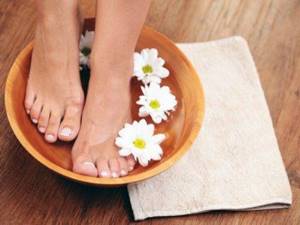
Even an amateur can do this task. We recommend: What is a hardware pedicure and what advantages does it have over the classic method of foot treatment?
First of all, you need to carefully examine the skin of your feet. To more accurately assess their condition yourself, you can use a mirror. If there is damage, the result may be a burn, which will lead to a spoiled appearance, and the following procedures will have to be postponed for a long time.
When performing a pedicure with fruit acids, it is imperative to disinfect the skin. After this, immerse your feet in a bath of warm water for three minutes, wipe dry and disinfect again.
After this, a chemical substance used to remove the corns is applied, it can even be a ready-made cream. You can also use a solution, for the preparation of which it is enough to follow the instructions. The composition is applied to the areas with problems using a cotton pad, then the legs are covered with cling film. The duration of the procedure is no longer than ten minutes.
After removing the film, the feet are wiped with a napkin, and using a wooden file (or a fine mesh file) the skin that has separated is rolled off. The direction of movement cannot be changed. After this, the disinfectant solution is applied again, and the feet are dried with a towel.
Then the areas with problems are processed, they are polished, for which an abrasive file or pedicure device with a special attachment is used.
When all stages are completed, varnish is applied to the nails and the design is completed.
Recommendations for performing the procedure
When carrying out manipulation, a number of requirements must be met:
- Do not use an acid solution without making sure there are no wounds, cracks, or fungus on your feet.
- You cannot keep the product for longer than the recommended time, trying to achieve effective removal of the dead stratum corneum. There should be no discomfort, tingling or burning sensation.
- To remove cuticles, do not apply the product to all your fingers at once, so as not to cause irritation.
- To protect your hands, you must use rubber gloves; when applying the product, you can use a special brush.
- Do not allow the product to come into contact with the nails (to avoid damage to the horny plate).
- When using fruit acid, you must use foot cream after the procedure.
Peeling with fruit acids as a skin care product can be performed no more than once every 7 days, which guarantees well-groomed and smooth legs.
Fruit acid for pedicure: use
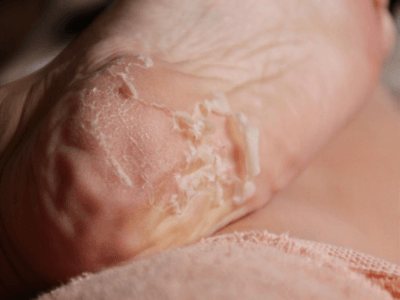
Fruit acid for pedicure is of plant origin, so its molecules are very small and can penetrate deep into the skin. The product can have different depths of penetration, it all depends on how concentrated the mixture is and how long it will act.
Fruit acid for pedicure has a less traumatic effect than a mechanical pedicure. Glycolic acid, on which chemical peeling is based, can act in combination with other drugs or independently. You can also use alkaline additives with it.
